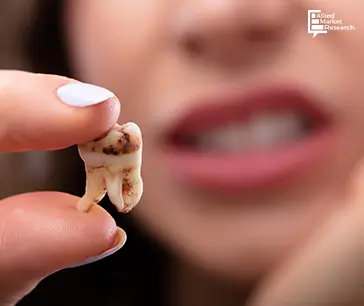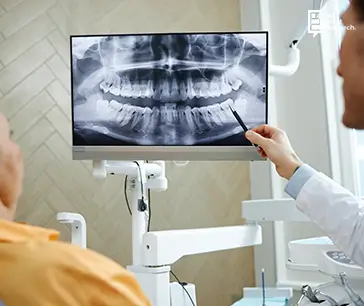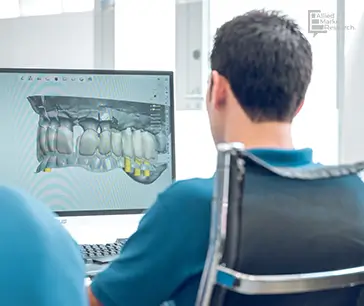Table Of Contents

Roshan Deshmukh

Trupti Wadekar
Dental Imaging: Transformative Power of Digital Imaging in Dentistry

Recent developments in dental imaging have transformed the field of dentistry. Technology, diagnostic devices, and imaging modalities have become fundamental components of modern dentistry by providing dentists with never-seen-before levels of insight into patient care, treatment planning, and diagnosis.
Dental imaging has undergone a transformative evolution in recent years, revolutionizing the landscape of oral healthcare. As technology continues to advance, diagnostic tools and imaging modalities have become integral components of modern dentistry, offering practitioners unprecedented insights for accurate diagnosis, treatment planning, and patient care. Dental imaging is used by dentists to capture detailed images of the teeth, gums, and other oral structures. These images are essential for diagnosing dental issues, planning treatment, and monitoring oral health.

Driving Factors of the Market
The growth of the dental imaging market is mainly due to the rise in number of people suffering from dental diseases such as tooth decay and continuous advancements in dental imaging technologies, such as digital radiography, cone-beam computed tomography (CBCT), and 3D imaging. For instance, the World Health Organization (WHO) in 2023, estimated that 3.5 billion people were affected with oral diseases. Early detection through advanced imaging techniques allows for prompt intervention and better treatment outcomes which is expected to drive the market growth. Thus, growing incidence of dental issues, including cavities, gum diseases, and oral cancers, propels the demand for diagnostic tools like dental imaging.

The table below represents the global market for the years 2022 and 2032 for the dental imaging market along with the CAGR.
| Market | 2022 | 2032 | CAGR% (2023-2032) |
| Dental imaging Market | $6,348.08 | $14,647.82 | 8.7% |
Source: AMR Analysis *Note: The market numbers & CAGR here are inclusive of the impact of COVID-19
Some patients and dental professionals may not be completely aware of the benefits and significance of utilizing cutting-edge imaging technologies in dental care in underdeveloped areas. Thus, limited awareness among dental professionals may result in a slower rate of adoption of dental imaging which negatively impacted the market growth. In addition, the high cost associated with the dental imaging systems further limits the adoption of dental imaging in emerging countries which hinders market growth.
Opportunity in the Market
Rise in technological advancements in imaging technology and the easy availability of a wide range of dental imaging systems are creating opportunities for companies to innovate and differentiate their products in a highly competitive market. For instance, in September 2022, Midmark Corporation, a provider of dental solutions, launched a new product line called the Midmark Extraoral Imaging System (EOIS) which includes 2D panoramic and 3D cone-beam computed tomography (CBCT) imaging X-ray devices. In addition, cone-beam computed tomography (CBCT) technology offers several benefits over traditional two-dimensional imaging technologies, such as better visualization of anatomical structures, reduced radiation exposure, and improved treatment. Thus, advanced features offered by dental imaging systems improved diagnostic precision and expanded treatment possibilities which provide lucrative opportunity to the market growth.
Competitive Landscape
The major players that operate in the dental imaging market are Acteon, Air Techniques, Inc., Corix Medical Systems, Cefla s.c., Dentsply Sirona Inc, Envista Holdings Corporation, J. MORITA CORP., Midmark Corporation Planmeca OY, and Vatech.

As per AMR analysis, the global dental imaging market was valued at $6,348.08 million in 2022 and is estimated to reach $14,647.82 million by 2032, exhibiting a CAGR of 8.7% from 2023 to 2032. North America accounted to be the largest revenue contributor in 2022, whereas Asia-Pacific is estimated to have the fastest growth accounting to be 11.2% from 2023 to 2032.
North America held the leading position in the market due to its well-developed healthcare infrastructure, rise in awareness among consumers about advancements in imaging technology, and widespread adoption of sophisticated dental imaging technologies. In addition, Asia-Pacific is expected to show lucrative growth in the coming years owing to a high population-base and growing demand for advanced dental care, and surge in awareness about oral health, coupled with a shift toward preventive dentistry practices.
Key players intending to engage in the dental imaging market can also find profitable prospects in emerging markets like Asia-Pacific and LAMEA. This is explained by the fact that these regions are marked by a substantial population base, rapid economic development, and increasing expenditures on healthcare. In addition, the market is expected to grow due to the rise in prevalence of dental disorders in these regions as well as increased awareness of advanced imaging technologies.
Additionally, the launch of new, cutting-edge dental imaging systems to meet patients’ unmet medical needs further fuels market expansion. In addition, factors including the growth in prevalence of dental disorders, rise in awareness about oral health and increased demand are driving the dental imaging market in the Asia-Pacific region. Thus, these factors provide significant opportunities for the players operating in the market.
Conclusion
Dental imaging has seen continuous innovation and adoption over the past decade, transitioning from traditional X-rays to advanced digital modalities such as intraoral scanners and CBCT. Technological improvements in imaging quality, radiation dosage reduction, software capabilities and intraoral applications have expanded the versatility and accuracy of dental diagnoses and treatment planning. Advanced modalities such as molecular imaging, hyperspectral imaging and nanotechnology applications are expected to open new capabilities and insights. Integration of artificial intelligence and deep learning algorithms will allow for highly customized and predictive treatment planning, automated image evaluations and improved clinical decision-making.

